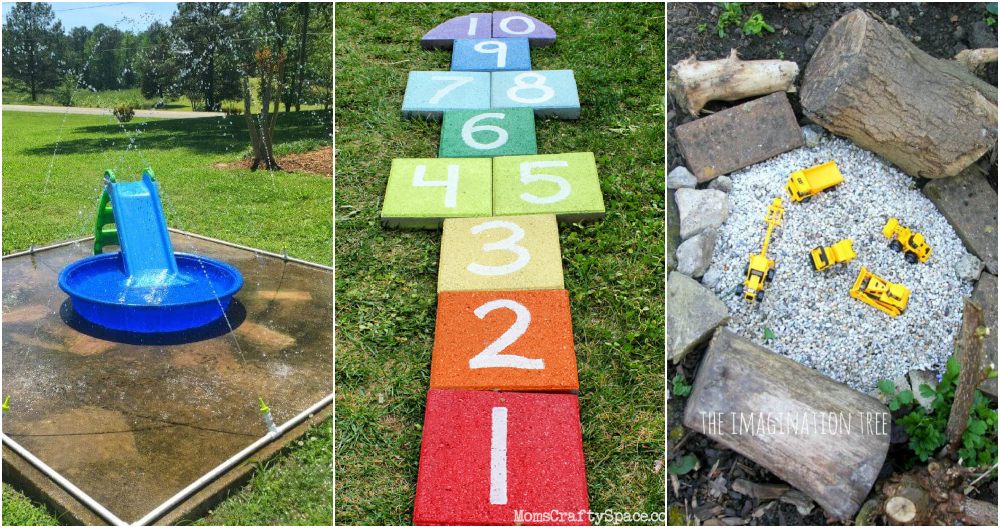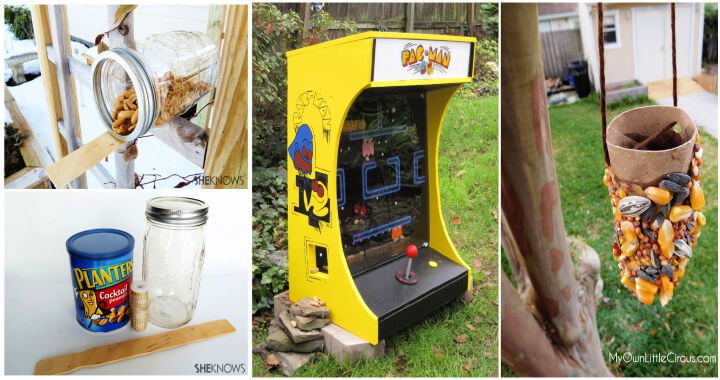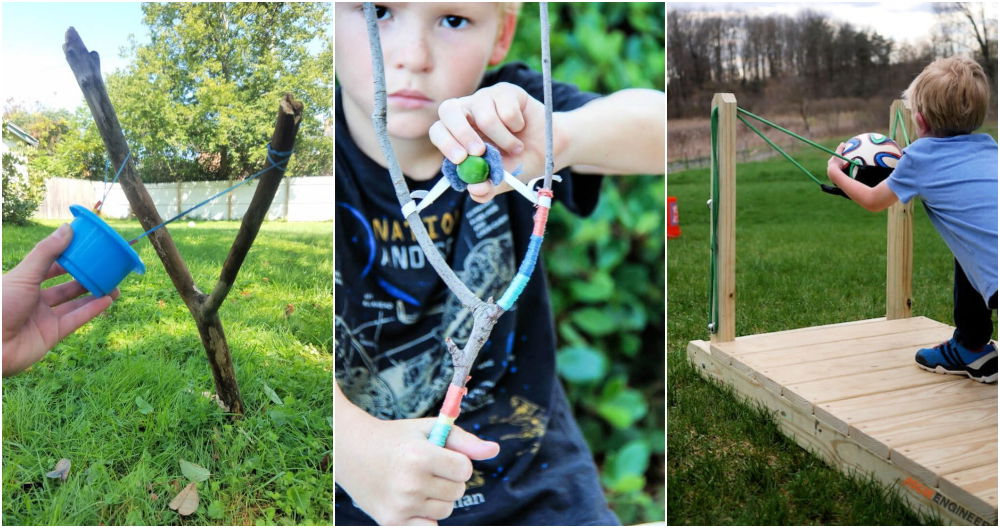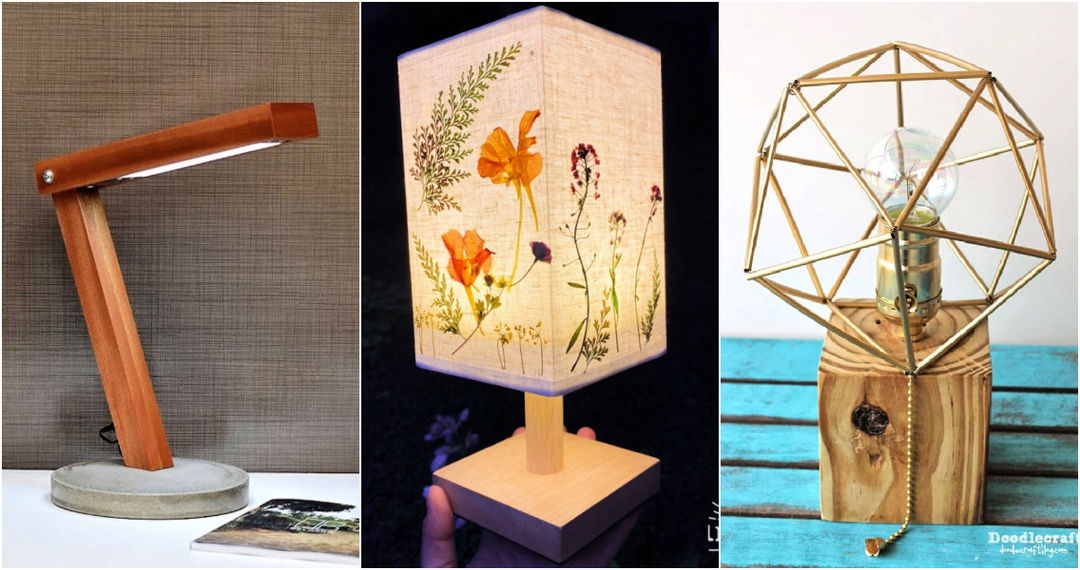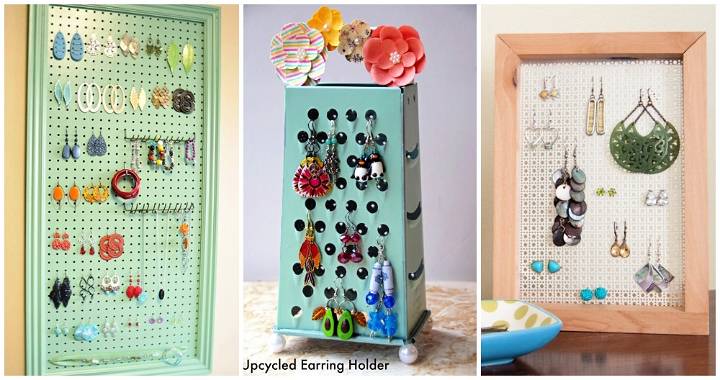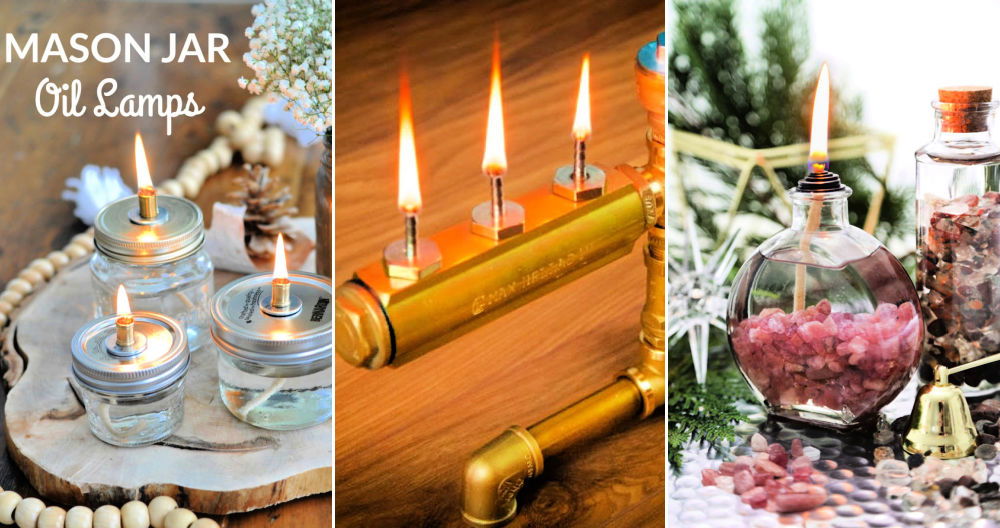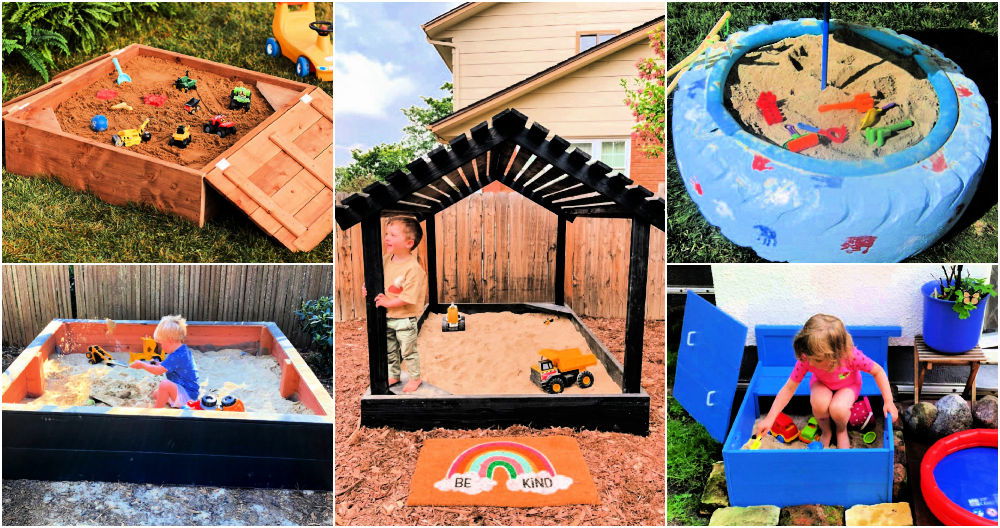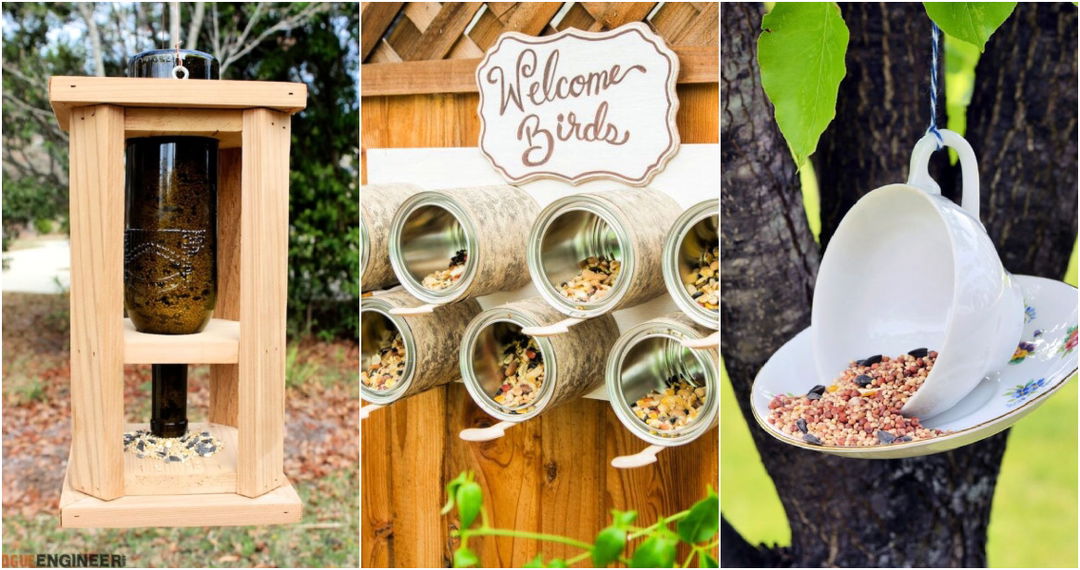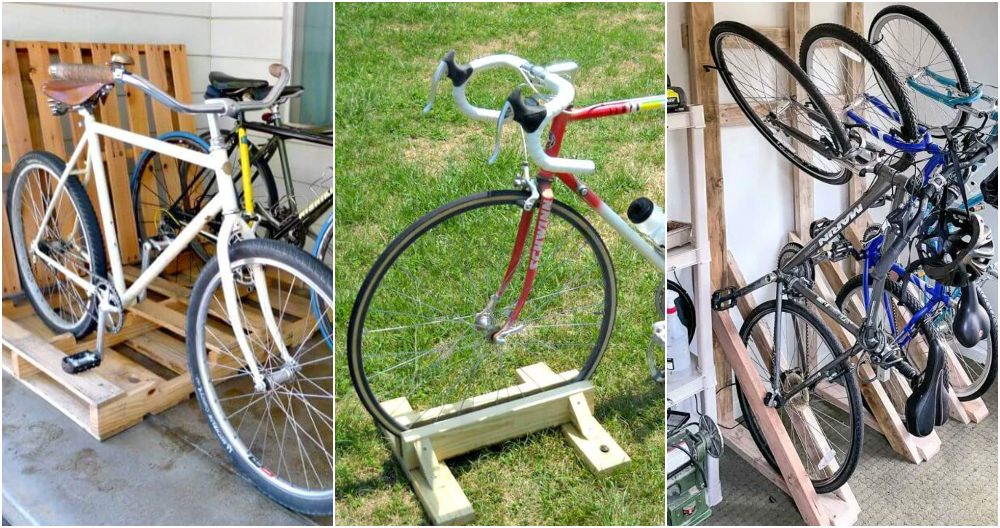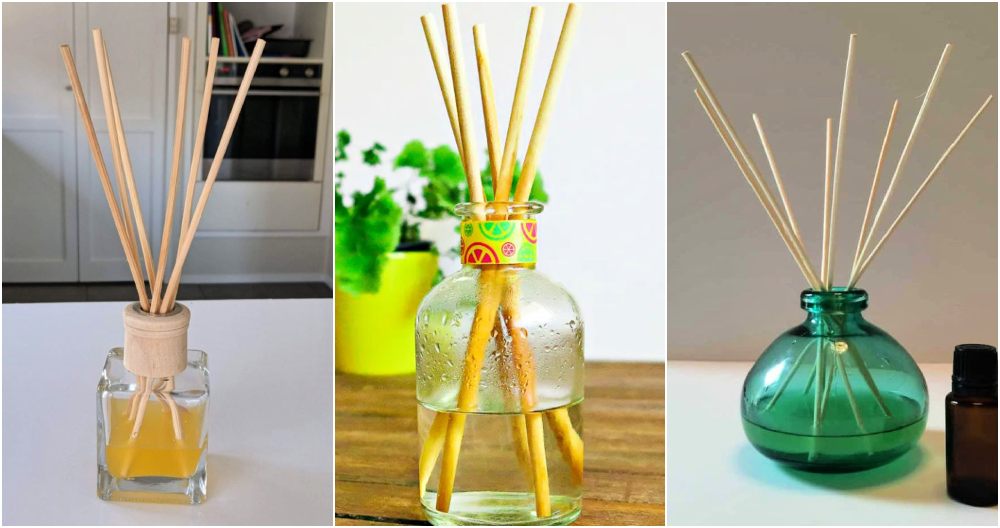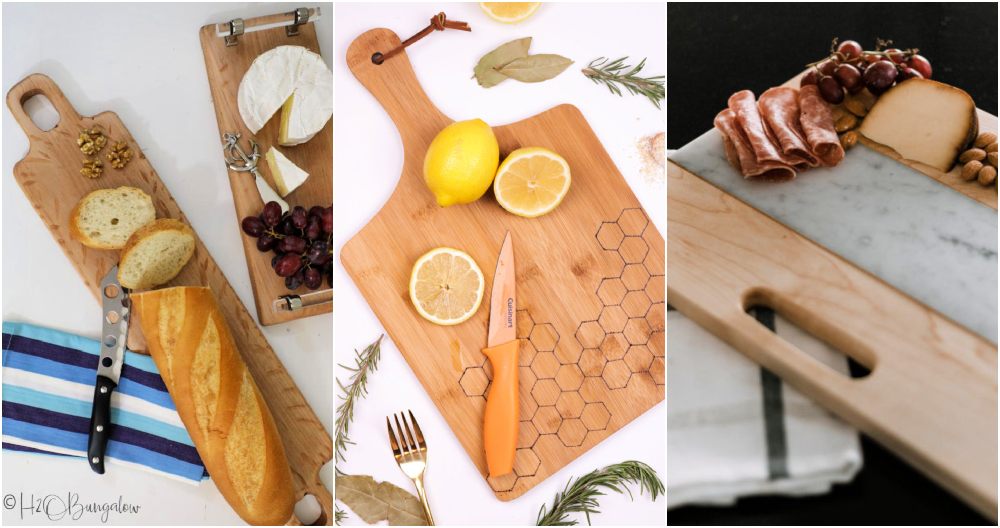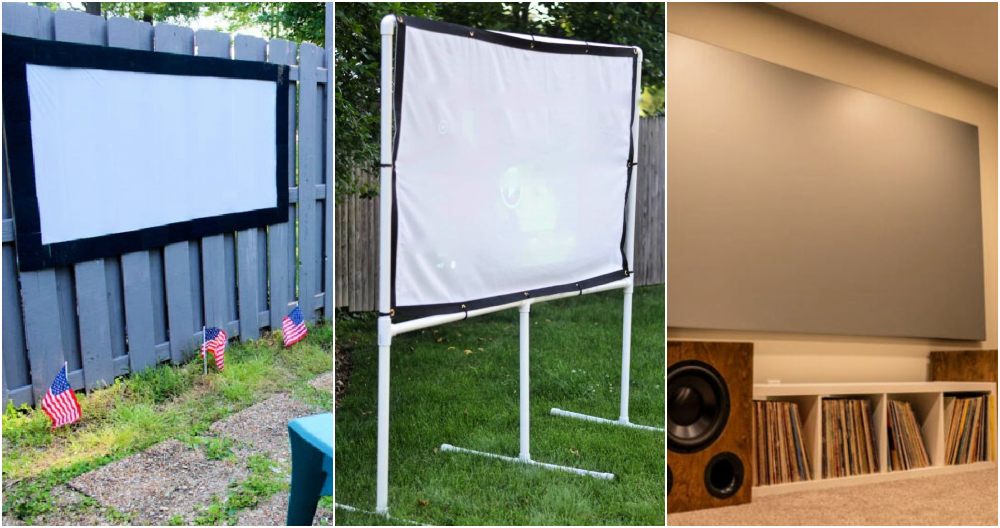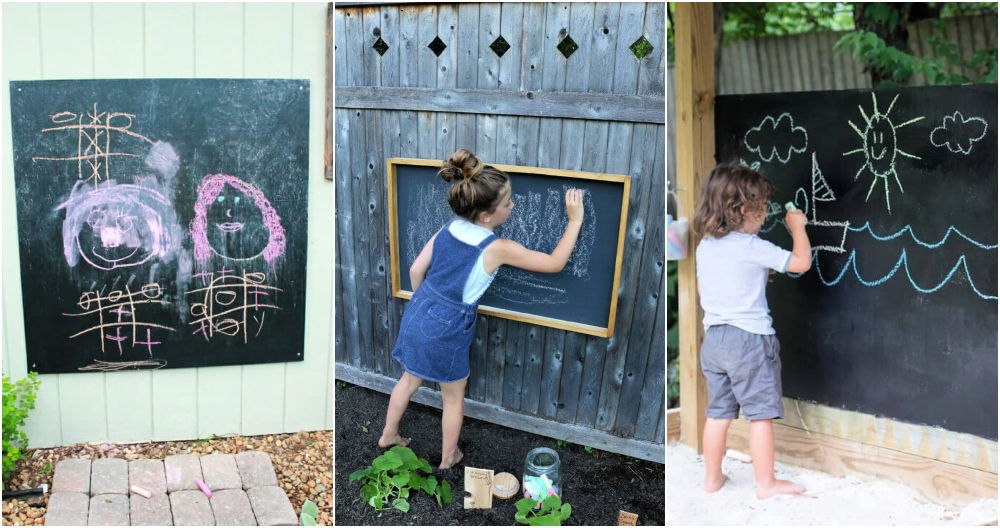Making your own DIY clock is a rewarding process that blends creativity with functionality. Homemade clocks offer a unique opportunity to design a timepiece that truly reflects your personal style. Whether you need a clock for your home, office, or as a thoughtful gift, mastering how to make a clock can be both enjoyable and fulfilling. This guide aims to equip you with the knowledge and inspiration to embark on your clock-making journey.
With a step-by-step approach, we'll walk you through the essential materials and tools needed, as well as the specific steps to craft a wooden clock from scratch. From cutting and preparing the wood to installing the clock movement, each phase is designed to be straightforward and manageable. If you've ever wondered about 25 DIY Clock Ideas or how to bring them to life, the next section promises to be an insightful resource.

Why Make Your Own DIY Clock?
Making your own DIY clock offers a myriad of benefits that go beyond just having a unique timepiece in your home. Here’s why you should consider diving into this creative endeavor:
- Personalization: By crafting your own clock, you have complete control over the design, size, and color. This means you can make a piece that perfectly matches your décor and reflects your personal style.
- Cost-Effective: Many store-bought designer clocks can be expensive. DIY clocks allow you to use affordable materials and repurpose items you may already have, saving you money.
- Sense of Achievement: Completing a DIY project brings a satisfying sense of accomplishment. You’ll feel proud every time you glance at your handmade clock, knowing it's a result of your creativity and effort.
- Eco-Friendly: DIY projects offer the opportunity to recycle and repurpose materials. Making your own clock from reclaimed wood, an old bicycle wheel, or a thrifted item reduces waste and gives materials a new life.
- Bonding Activity: Crafting can be a fun activity to do with friends or family. Working on a DIY clock project together can be a bonding experience and a way to spend quality time with loved ones.
- Learning Opportunity: Every DIY project is a chance to learn new skills or improve existing ones. Whether it's woodworking, painting, or working with different tools, making a clock can enhance your crafting abilities.
Embracing DIY clock-making not only beautifies your space but also enriches your life with personal growth and sustainable practices.
How to Make a Clock
Making a DIY wooden clock from scrap wood is not only an eco-friendly project but also a fantastic way to sharpen your woodworking skills. This beginner-friendly guide will take you through the process step by step, ensuring you end up with a functional and aesthetically pleasing wooden clock. Whether you're new to woodworking or looking to use up those leftover wood pieces, this project is for you.
Materials and Tools Needed
- Scrap wood
- Wood glue
- Miter saw
- Planer
- Chisel
- Sander with 80 and 180-grit sandpaper
- Ruler or measuring tape
- Pencil
- Router with a 35mm forstner bit and a flush trim bit
- Double-sided tape
- Clock movement kit (with a long shaft)
- Light oak stain and Danish Oil
- Masking tape
- Epoxy
- Drill with various drill bits
Steps to Make the Wooden Clock
Learn how to make a wooden clock with our step-by-step guide below:
1. Cutting and Preparing the Wood
Start by selecting scrap wood pieces that are three centimeters wide. You'll need enough pieces to make ten strips that can be joined to form a 30-centimeter square. Use a miter saw to cut the pieces to length and then plane the two opposite faces of each strip to ensure they are flat and uniform.
2. Gluing the Strips Together
Arrange the ten strips so they sit flush next to each other. Apply wood glue along one edge of each strip and press them together, ensuring the glued edge is facing downsides towards the back fence of your clamping setup. This ensures a level surface needing less planing work later. Leave the glue to dry overnight.
3. Additional Planing and Sanding
After the glue has dried, use a chisel to remove any hardened glue and then plane the surfaces again for a smooth finish. Sand the entire piece starting with 80-grit sandpaper and then finish with 180-grit for a finer texture.
4. Making the Clock Face
Mark the center of your wood square by measuring and drawing the diagonals. Use a router with a 35mm forstner bit to prepare the recess for the clock movement. Ensure your circle is centered before routing. If required, you may need to route from both sides due to limited bit depth.
5. Finishing Touches
Round over the edges of the clock face for a softer look using the router with a round-over bit and follow up with more sanding if necessary. Apply a coat of light oak stain to achieve your desired color, allowing it to dry before finishing with Danish oil for a protective layer.
6. Installing the Clock Movement
Measure and drill the hole for the clock movement shaft at the center of the clock face. Check the length of the shaft against the thickness of the wood and, if necessary, recess the clock movement into the back of the piece to ensure the shaft protrudes enough for mounting the clock hands. Use epoxy to secure the clock movement if needed, then finalize by attaching the clock hands according to your kit's instructions.
Video Tutorial
For a visual step-by-step guide, watch this YouTube video on making a DIY wooden clock.
This video complements the written guide by demonstrating the discussed techniques in an engaging and easy-to-understand way, enhancing your understanding and knowledge.
By following these detailed steps, you'll craft not just a stylish timepiece but also a testament to your growing woodworking skills. Enjoy the process and the satisfaction of completing a project that marries functionality with aesthetic appeal.
DIY Clock Project: Ensuring Your Safety
Making your own DIY clock can be a fulfilling project.. However, it's crucial to prioritize your safety while working on this creative endeavor. Here are some essential safety precautions to keep in mind:
Protective Gear
- Eye Protection: Always wear safety goggles or glasses to protect your eyes from flying debris, especially when cutting or drilling.
- Gloves: Use gloves to safeguard your hands from sharp edges and harmful chemicals in paints or glues.
- Hearing Protection: If your project involves loud power tools, protect your hearing with earmuffs or earplugs.
Proper Ventilation
- Work in a Well-ventilated Area: When using spray paints, adhesives, or solvents, ensure you're in a well-ventilated space to avoid inhaling fumes. Open windows or work outside if possible.
Safe Handling Practices
- Read Labels and Manuals: Before using any tool or material, read the labels and instruction manuals. Familiarize yourself with their proper use and the recommended safety precautions.
- Keep Your Workspace Organized: A cluttered area can lead to accidents. Keep your workspace tidy and ensure all tools are stored safely when not in use.
- Be Mindful of Your Surroundings: Always be aware of your surroundings, especially if you're working in a shared space. This helps prevent accidents involving bystanders.
By following these safety precautions, you'll not only ensure a successful DIY clock project but also a safe one.
Customization Options for Your DIY Clock
Creating a DIY clock offers a fantastic opportunity to inject your personality and style into your space. Below, we delve into two major customization options: color choices and numerals/markings. These elements can significantly impact your clock's look, making it a unique piece that reflects your taste.
Color Choices
The color palette you choose for your DIY clock can dramatically alter its vibe and compatibility with your room. Here are a few ideas:
- Monochromatic Scheme: A monochromatic color scheme involves selecting a single color and using various shades, tones, and tints of that color. This creates a sleek and cohesive look, ideal for modern or minimalist decor.
- Contrasting Colors: For a more vibrant and eye-catching clock, consider using contrasting colors. Refer to the color wheel and pick colors opposite each other, like blue and orange or yellow and purple. This choice is perfect for rooms that need a pop of color.
- Pastels for Softness: Soft pastel colors like light pink, baby blue, and mint green can create a soothing and calming effect. These are excellent for bedrooms or nurseries where you want a gentle touch of color.
- Metallics for a Luxe Feel: Gold, silver, and bronze can add a touch of luxury and sophistication to your clock. Use metallic paints or finishes to achieve this elegant look, suitable for more formal spaces or as a statement piece.
Numerals and Markings
The style of numerals and markings on your clock not only contributes to its aesthetic but also to its readability and character. Here are some creative ideas:
- Classic Roman Numerals: For a timeless look, Roman numerals are a great choice. They work well with traditional decor and add an element of sophistication to any clock.
- Modern Minimalist: If you prefer a more modern look, consider simple line markings or even no markings at all. This minimalist approach suits contemporary interiors and emphasizes clean lines.
- Personal Symbols: Who says you have to stick to numbers? Use symbols that mean something to you or your family. This could include stars, hearts, or even small icons representing your hobbies or interests.
- Mixed Media Numbers: Get creative with materials for your numerals. Think of using buttons, fabric cut-outs, or even small objects glued to the clock face. This approach adds texture and interest, making your clock a true conversation piece.
When customizing your DIY clock, let your creativity guide you. By choosing colors and numerals carefully, you can make a clock that reflects your personal style.
Troubleshooting Tips for DIY Clock Making
Creating your own clock can be a rewarding project. However, even with careful planning, you might run into some common issues. Below, we'll cover how to solve problems like misaligned clock hands, paint smudges, and uneven surfaces, ensuring your clock-making experience is as smooth as possible.
Misaligned Clock Hands
Symptoms: Your clock hands might overlap incorrectly or not move smoothly.
- Check the Tightness: The first step is to ensure the nut holding the clock hands is not too tight. It should be secure but not so tight that the hands can't move freely.
- Alignment: If the hands are sticking or overlapping at certain points, gently press them towards the clock face. Make sure they are not touching each other or the clock face itself.
- Battery Power: Weak batteries can cause the hands to move sluggishly or stop. Replace with a new battery to see if it solves the issue.
Paint Smudges
Symptoms: Accidental smudges or drips on your DIY clock face.
- Wipe Off Wet Paint: If the paint is still wet, quickly wipe it off with a damp cloth. Be gentle to avoid spreading the smudge.
- Sand Dry Paint: For dry paint smudges, lightly sand the area with fine-grit sandpaper until the smudge is gone. Then, touch up the area with paint.
- Masking Tape: In future projects, use masking tape to cover areas you don't want painted. It's an effective way to prevent smudges.
Uneven Surfaces
Symptoms: Your clock doesn't hang straight due to an uneven back surface or it wobbles if placed on a table.
- Sand the Surface: If the surface is slightly uneven, use sandpaper to smooth it out. Start with a coarser grit and finish with a fine grit for a smooth finish.
- Felt Pads: For minor unevenness, especially for clocks meant to sit on a surface, stick felt pads on the bottom. They can compensate for small imperfections.
- Hanging Adjustments: If the issue is with wall hanging, ensure your mounting hardware is properly installed. Sometimes, adding a small bumper pad on the back of the clock can balance it out.
Remember, patience and attention to detail are key in DIY projects. Don't rush, and if you encounter a problem, take a step back to assess and apply these troubleshooting tips. Your DIY clock will not only be a unique piece of decor but also a testament to your problem-solving skills.
Maintenance and Care for DIY Clocks
Ensuring your DIY clock remains in top condition involves regular maintenance and care. Here's how you can keep your clock ticking smoothly for years to come.
Battery Replacement
When to Replace: Most DIY clocks are powered by batteries that need replacement once they run low, typically every 1-2 years. If your clock starts losing time or stops altogether, it's time for a new battery.
Steps to Replace:
- Open the Back: Carefully open the back compartment of your clock. This usually involves unscrewing a panel or sliding it open.
- Identify Battery Type: Check the type of battery your clock uses (commonly AA or AAA) and ensure you have the correct replacement.
- Remove Old Battery: Gently remove the old battery. Note the battery’s orientation so you can insert the new one correctly.
- Insert New Battery: Place the new battery in, aligning the positive (+) and negative (-) ends as the old one was positioned.
- Close and Test: Secure the back panel and set the correct time. Observe if the clock starts functioning properly.
Dust and Cleaning
Keeping Dust-Free: Dust can hinder the performance of your clock. Regular dusting prevents buildup and maintains the clock's appearance.
Cleaning Tips:
- Soft Cloth: Use a soft, dry cloth for dusting. Avoid water or cleaning solutions unless the clock is designed to be water-resistant.
- Gentle Cleaning: For tougher spots, slightly dampen the cloth with water or a mild cleaning solution, then gently wipe the area.
- Avoid Moisture: Ensure no moisture enters the internal mechanisms of the clock.
Adjustments
Syncing Clock Hands: If your clock hands become misaligned or fall out of sync, follow these steps to adjust them.
- Open the Clock: Carefully access the clock hands by opening the front or back of the clock, depending on the design.
- Gently Adjust Hands: Manually move the hands to the correct time. Use gentle pressure to avoid bending them.
- Use Adjustment Knobs: Some clocks come with adjustment knobs at the back. Use these to align the hands without opening the clock.
- Test: Once adjusted, observe the clock over a few hours to ensure it keeps time accurately.
Regular maintenance, including timely battery replacement, cleaning, and adjustments, will ensure your DIY clock remains a reliable and attractive timekeeper. Simple, regular checks can prolong the life of your clock, keeping it ticking beautifully.
DIY Clock Ideas FAQs
Making your own clock can be a rewarding project. Here are some frequently asked questions to help you get started.
What materials do I need to make a DIY clock?
- Basic materials: You'll generally need a clock mechanism kit, which includes the clock hands and movement. The type of face you choose, such as wood, concrete, or recycled items, depends on your design.
- Tools: Common tools include a drill, paint or stain (if desired), sandpaper, and possibly a saw, depending on the material you're using for the clock face.
- Decorative elements: Depending on your design, you might want decorative items like paint, decals, or wood stain.
Can I make a clock without woodworking skills?
Yes, there are many DIY clock projects that don't require advanced woodworking skills. Projects using materials like concrete, paper plates, or embroidery hoops are great starting points for beginners.
How do I choose the right clock movement kit?
The choice of clock movement kit depends on the thickness of your clock face and the style of hands you prefer. Look for a "shaft length" that matches the thickness of your clock face, ensuring the hands will move freely.
What are some creative ideas for DIY clock faces?
- Upcycled items: Old records, books, and bicycle wheels can make unique clock faces.
- Natural materials: Consider using slices of wood, driftwood, or even a sturdy leaf.
- Household items: Plates, embroidery hoops, and canvas can be transformed into clock faces.
How can I customize my DIY clock?
Customizing your clock can involve:
- Painting or staining the clock face in colors that match your decor.
- Adding numbers or markers using stickers, painting, or attaching objects like buttons or beads.
- Incorporating thematic decorations to fit a room’s style, like a nursery or kitchen.
How do I ensure my DIY clock works correctly?
- Secure the mechanism: Make sure the clock mechanism is securely attached to the clock face and that the hands are properly fixed to the mechanism.
- Correct alignment: Ensure the clock hands are not touching each other or the clock face, which could prevent them from moving.
- Battery: Use a fresh battery and check that it’s properly inserted.
Can DIY clocks be a good gift idea?
Absolutely, a handmade clock is a thoughtful and personal gift. You can customize it to suit the recipient's taste or to commemorate a special occasion, making it a memorable and unique present.
By addressing these common questions, you're well on your way to making a unique and personalized timepiece. Whether you're crafting for yourself or as a gift, the process is sure to be rewarding.
25 Homemade DIY Clock Ideas (How to Make a Clock)
Discover 25 creative DIY clock ideas and learn how to make your own unique timepiece at home. Get inspired and start crafting today!
1. Easy DIY Sliced Cake Wall Clock
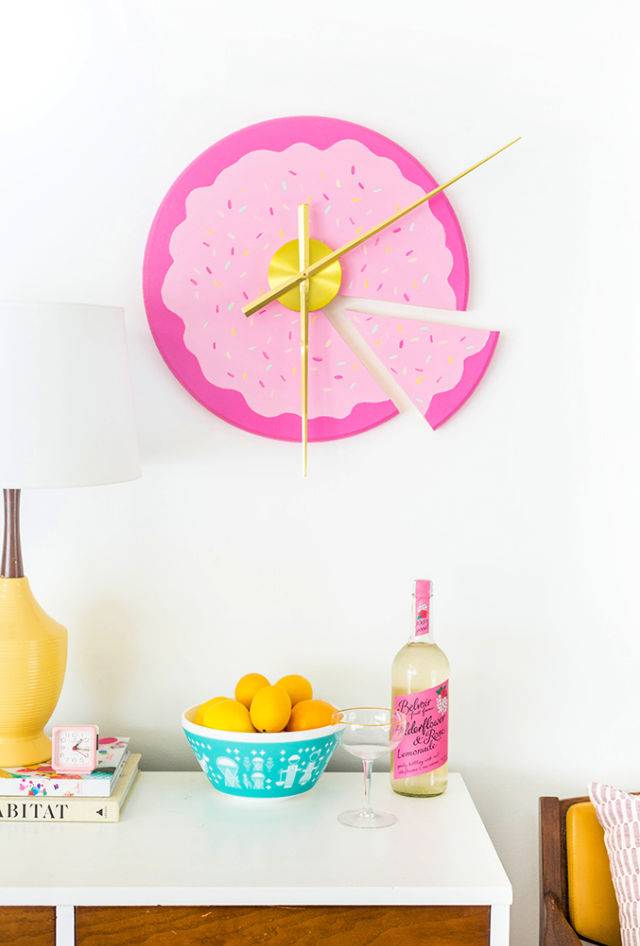
Ready to add a dash of whimsy to your home decor? Dream Green DIY's tutorial on crafting a DIY Sliced Cake Wall Clock is perfect for those who love unique and playful projects. With clear, step-by-step instructions, you'll transform a simple wood round into a colorful timepiece that resembles a slice of cake.
You'll need basic tools like a jigsaw, along with paint and a clock mechanism. Sanding, priming, and painting each piece makes the illusion of cake and icing, complete with sprinkles for a charming finish. Hang it up in a child's room, kitchen, or bakery to infuse a sweet touch into your space. Give it a try, and watch your creativity tick along!
2. Modern Handmade Chic Plywood Clock
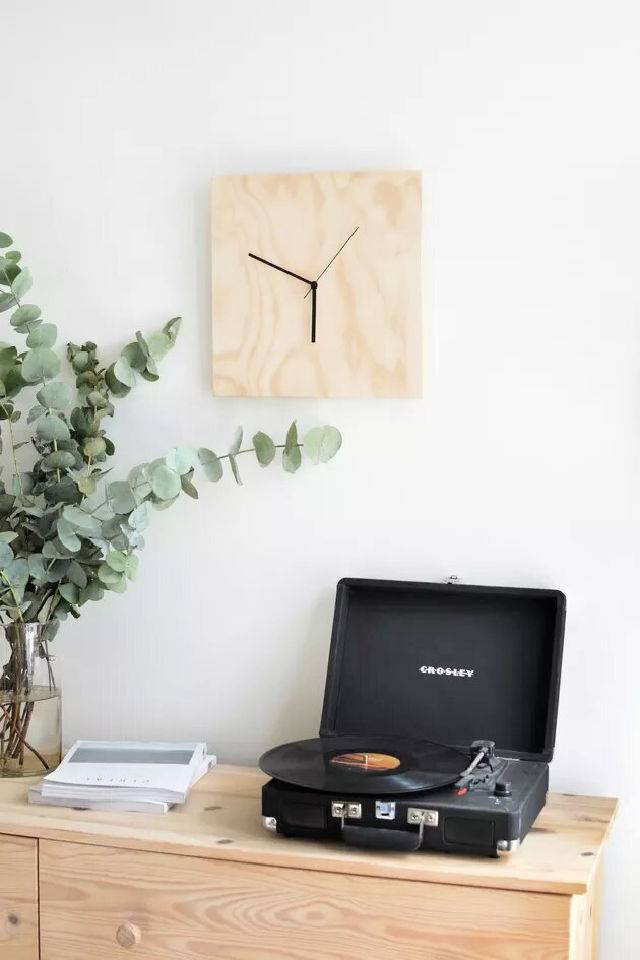
Get inspired with these DIY clock ideas to create timepieces that uniquely reflect your style. Make a sleek, Scandinavian-inspired plywood clock with ease by following Hunker's simple DIY guide. Ideal for anyone who enjoys crafting, this project requires minimal tools like a jigsaw, power drill, and wood glue.
You'll start by cutting and sanding a plywood square for the clock face, then drill a center hole to fit the clock mechanism. Secure the mechanism, attach battens for a flush wall fit, and add a hook for hanging. Finish by assembling the clock arms and inserting a battery. This chic timepiece adds a modern touch to any space and can be completed quickly, making it a perfect weekend project.
3. How to Make a Mid-Century Wall Clock
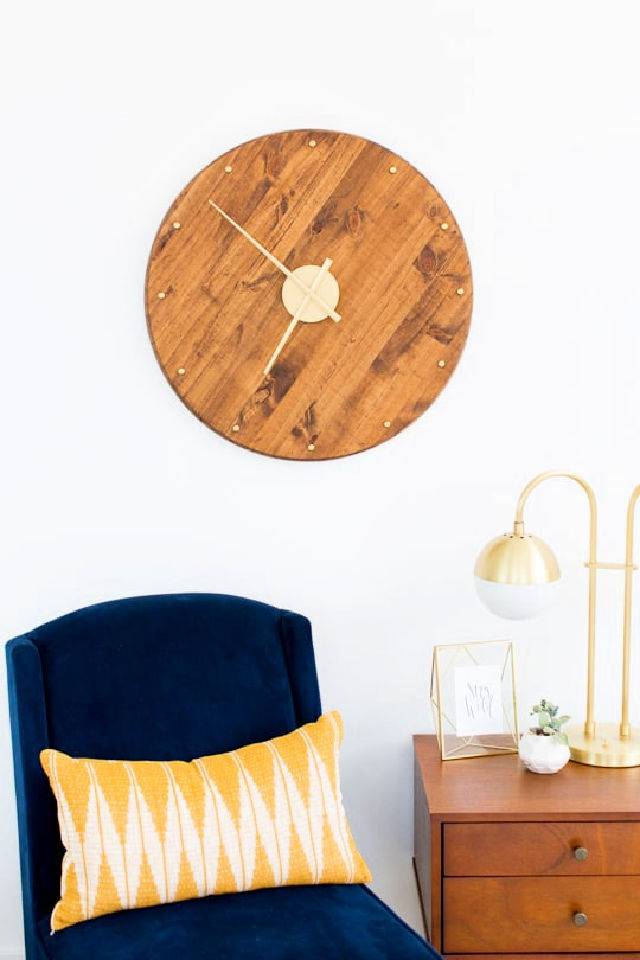
Add a touch of retro flair to your home with a DIY Mid-Century Wall Clock, a project that combines modern charm with a classic design. Sugar & Cloth offers a step-by-step guide to making this stylish timepiece that not only serves as functional decor but also as a conversation starter. With a simple list of materials like a wood round, stain, clock movement, and dowel caps, you can craft a unique wall clock that enhances any room.
The process is straightforward, making it a great weekend project. By customizing the stain color and choosing to add metallic paint, you'll end up with a personalized clock that reflects your taste and complements your living space. Enjoy the satisfaction of making a beautiful wall clock that rivals those found in stores, at a fraction of the cost.
4. Adorable DIY Colorblock Wall Clock
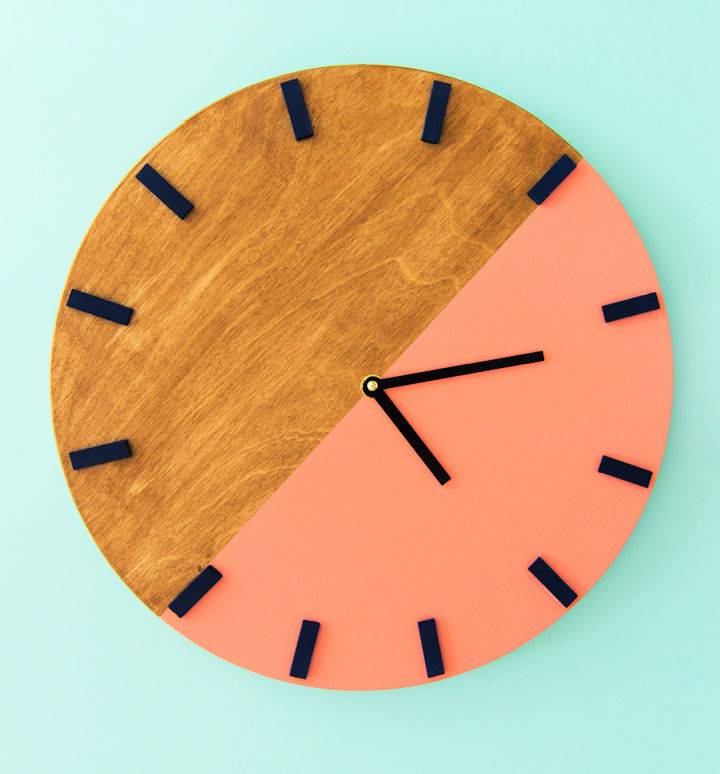
Transform your space with a handmade touch by making a stylish color block wall clock, inspired by a find from Oliver Bonas. Sarah Hearts offers a simple and engaging guide to crafting your own timepiece with a personal flair. With basic supplies like a wood clock panel, paint, and a clock mechanism, you can design a clock that complements your decor.
Follow the step-by-step instructions to stain, paint, and assemble a unique wall accessory that's both functional and a statement piece for your home. It's an easy project that requires no advanced crafting skills, making it perfect for anyone eager to add a homemade element to their living space.
5. How to Build a Concrete Clock
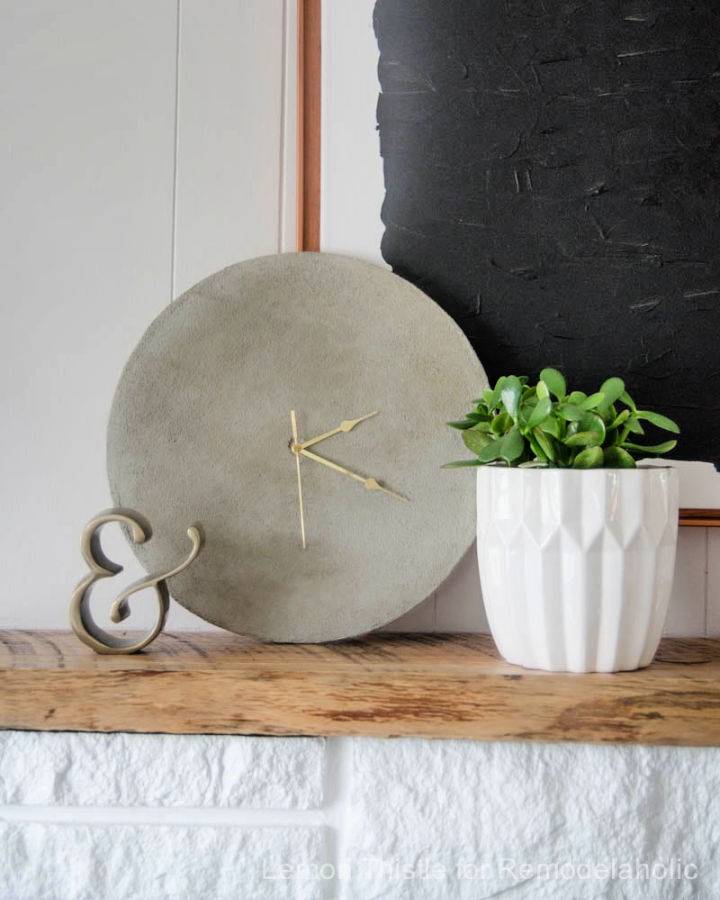
Ready to add a touch of modern industrial style to your space? Remodelaholic presents a DIY Concrete Clock tutorial that's simple and mess-free. Using a wood round as a base and a clever mortar repair kit, this project avoids the need for complex molds. Just mix, apply, and smooth the mortar over the wood, let it dry, and install the clock mechanism with some construction adhesive.
Perfect for those who appreciate a hands-on approach to home decor, this guide ensures you can make a stylish timepiece that's both functional and a statement piece for your entryway or mantel. With easy-to-follow steps and minimal fuss, your new concrete clock will be ticking in no time.
6. Build Your Own Wooden Clock
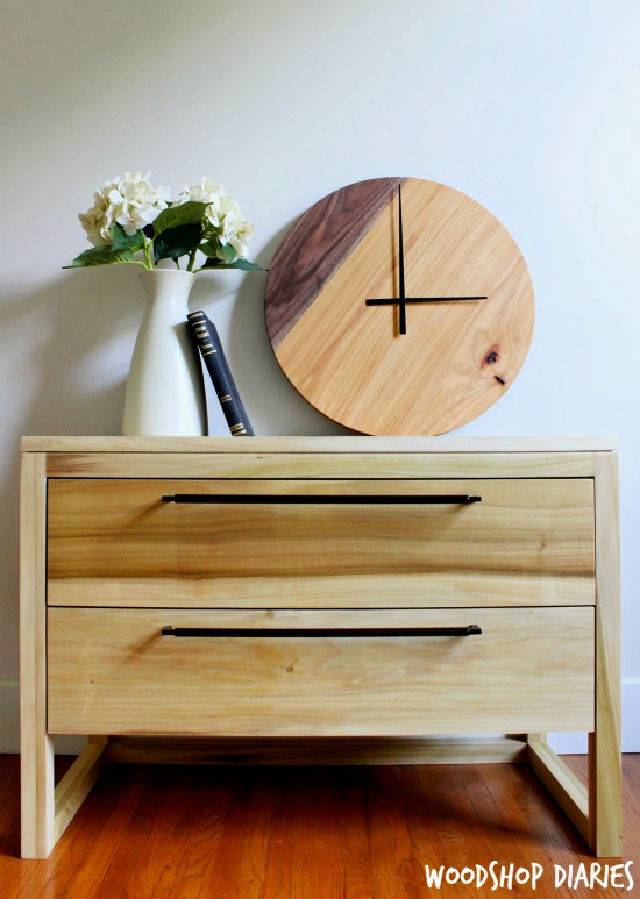
Explore elegant wooden clock ideas to add a touch of nature to your home decor. Make a stunning two-tone modern wall clock with ease using the DIY guide from Woodshop Diaries. This project is perfect for those who enjoy woodworking and are keen on adding a handcrafted touch to their decor. You'll need simple materials like wood boards, a miter saw, wood glue, and a clock kit.
Follow the step-by-step instructions to cut, glue, and assemble your clock, and finish it off with a sleek coat of Danish oil. Whether displayed on a wall or a shelf, this DIY wood clock promises to be a charming addition to any room. Dive into the full tutorial on Woodshop Diaries and start building your own timeless piece today.
7. Mid-Century DIY Esque Starburst Clock
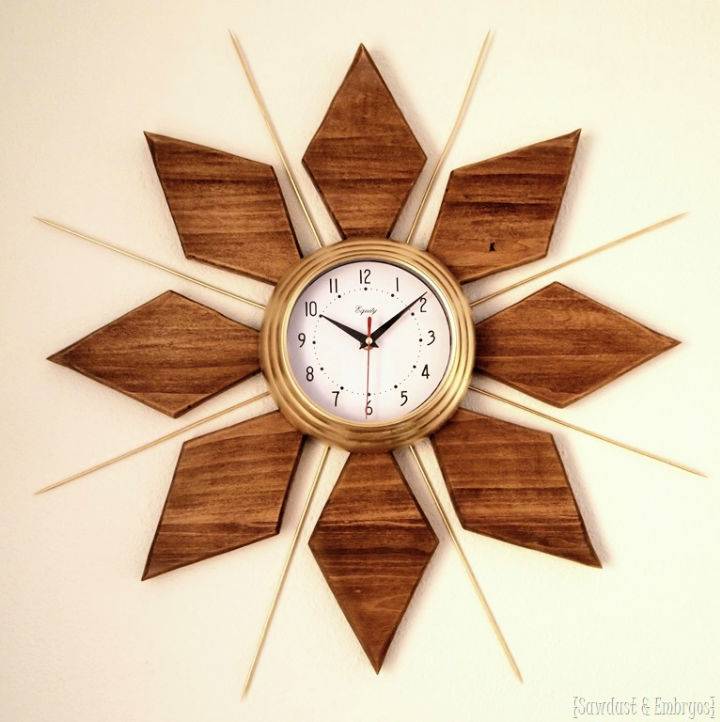
Transform your space with a touch of vintage flair by crafting a Mid-Century Modern-esque Starburst Clock, as showcased on Reality Daydream. Bethany Sy guides you through the process with a detailed, step-by-step approach that is both engaging and informative.
From selecting the right materials to the final touches, this DIY project is perfect for adding a retro vibe to your décor. The instructions are clear and concise, ensuring an enjoyable crafting experience. Dive into this creative endeavor and make a statement piece that's not only cost-effective but also a unique expression of your style.
8. Homemade Pallet Wood Clock
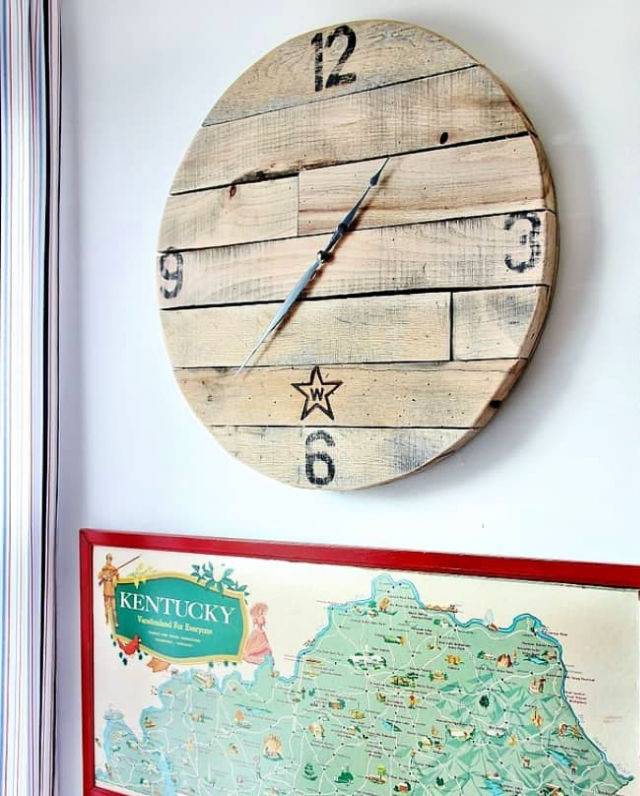
Transform your walls with these artistic DIY wall clock ideas, perfect for any room. Remake your wall with a touch of rustic charm by crafting a pallet wood clock, a creative DIY project from Thistlewood Farm. KariAnne Wood guides you through the process with clear, step-by-step instructions. From dismantling pallet boards to attaching high-torque clock hands, this guide is designed to be helpful and engaging.
With simple tools and materials like wood glue, plywood, and a jigsaw, you'll make a functional piece of art that adds industrial flair to any room. Embrace the satisfaction of making your own pallet wood clock, a project that's not just about telling time, but about showcasing your crafting skills.
9. Making a Wood Clock Using Scrap Plywood
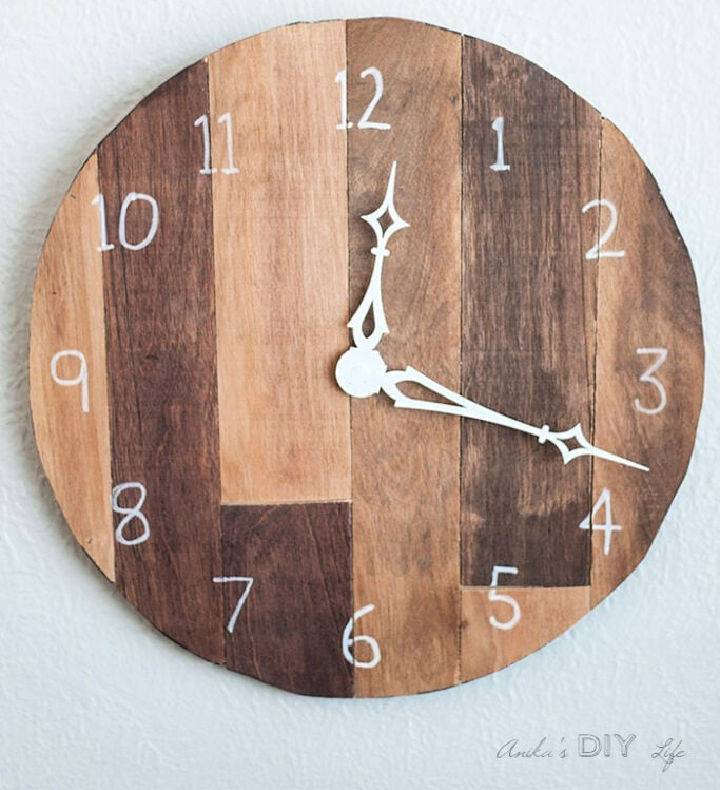
Transform your leftover scrap plywood into a charming, custom wall clock with Anika's DIY Life's simple tutorial. With a wall clock kit and basic tools, you can craft a unique timepiece that adds a personal touch to your home decor.
This guide walks you through the process step by step, from cutting the base to attaching the clock mechanism. Ideal for DIY enthusiasts, the project allows for creativity, offering options to stain or paint the wood for various looks. An engaging and practical way to repurpose materials, making this wood clock is both rewarding and functional.
10. DIY Embroidery Hoop Clock for Kids
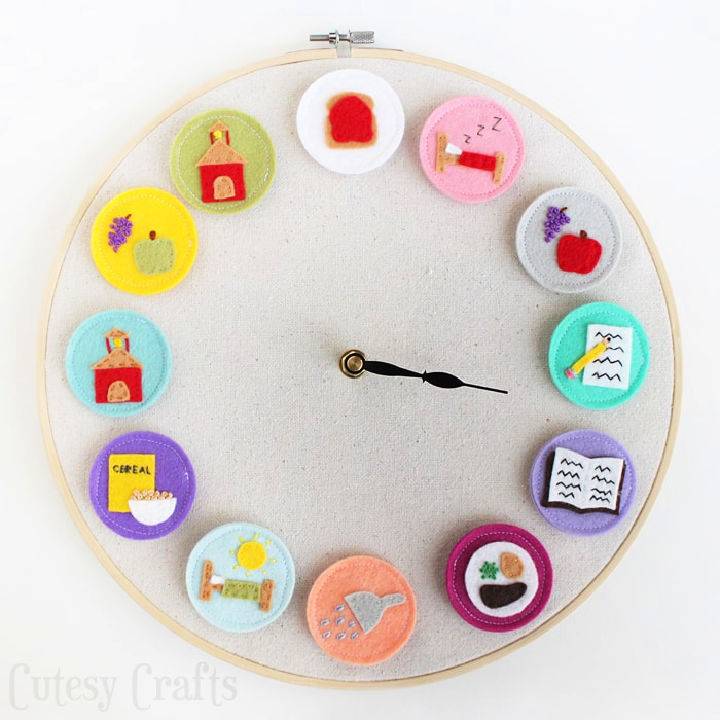
Make a fun and functional DIY Clock for Kids with guidance from Cutesy Crafts! This project is perfect for helping children learn about daily schedules and time management. Using an embroidery hoop, a canvas drop cloth, and a clock kit from your local craft store, you can craft a clock that features interchangeable activity pieces attached to Velcro.
The design allows for flexibility in your family's routine, and the simple, clear instructions make assembly a breeze. Delight your kids with this homemade clock that not only teaches them about time but also cuts down on the constant questions about when things will happen. Visit Cutesy Crafts for the full tutorial and free patterns to make learning time enjoyable for your little ones.
11. How to Make a Color Block Clock
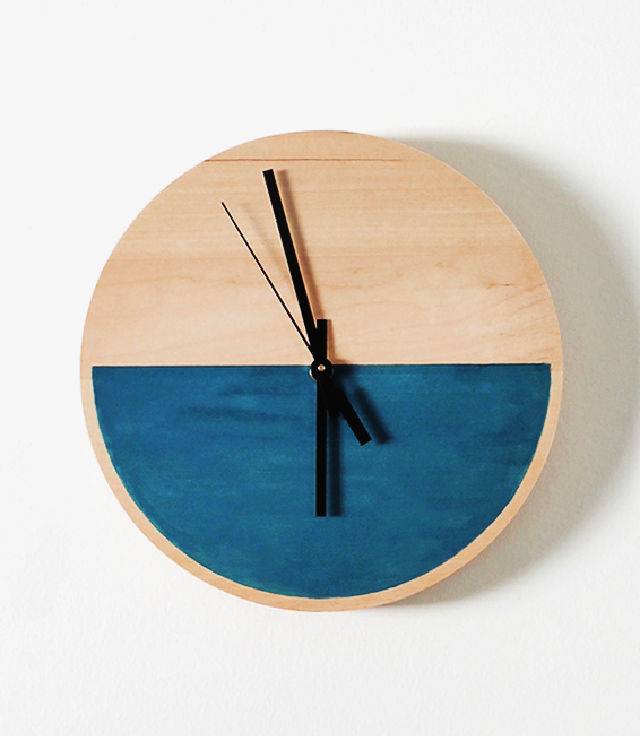
Ready to add a personalized touch to your home decor? Follow this simple guide from Almost Makes Perfect to make a stylish DIY color block clock. All you need is a wooden clock base, a clock kit, acrylic paint, and a few other basic supplies. Start by sanding the clock face for a smooth texture.
Then, use painter's tape to achieve crisp lines, and trace a semi-circle for an artistic touch. Thin your paint with water for a wash effect, and carefully paint around your traced shape. Once dry, peel off the tape, assemble the clock kit, and voila you've crafted a unique timepiece that also makes for a thoughtful handmade gift.
12. Make Your Own Bicycle Wheel Clock
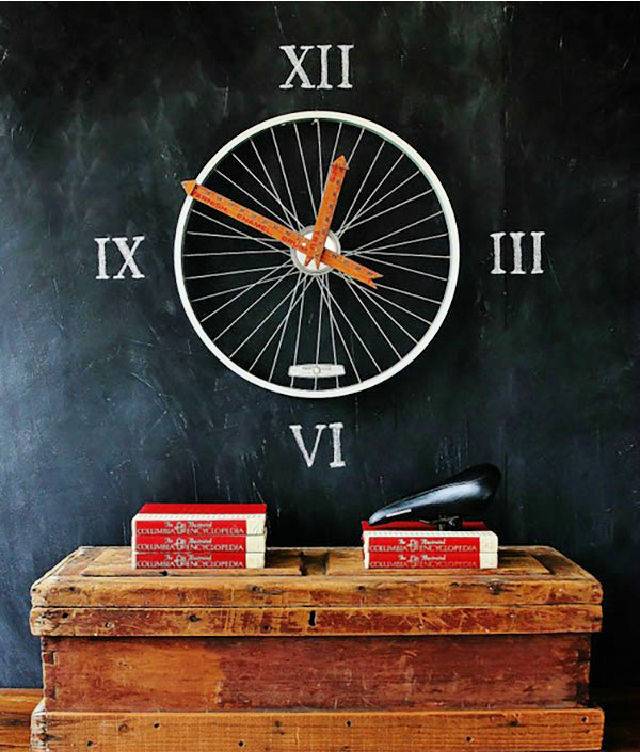
Discover wooden clock designs that blend traditional craftsmanship with modern aesthetics. Transform an old bicycle wheel into a charming and functional piece of home decor with this DIY bicycle wheel clock tutorial. Home sweet Homes Brings you an engaging step-by-step guide from kari anne at thistlewood farms.
With simple supplies like a bike wheel, paint stick can lid, weights, and a clock kit, you can craft a unique clock with vintage yardstick hands. Learn to attach and balance the hands, and even personalize the clock face with Roman numerals on a chalkboard background. This project is not only a creative way to upcycle but also adds a quirky touch to any room. Follow these instructions for a satisfying DIY experience and a beautiful timepiece.
13. DIY Roman Numeral Clock Tutorial
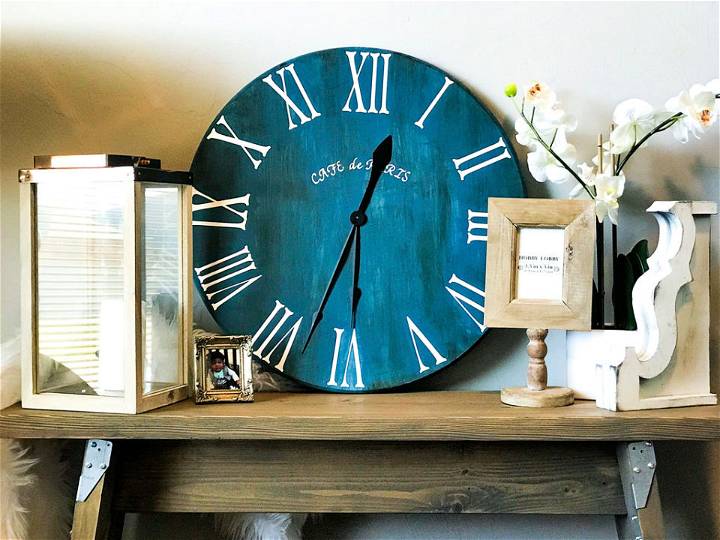
Make a striking Roman numeral clock with ease using Ashley Basnight's comprehensive tutorial on Handmade Haven. This engaging guide provides step-by-step instructions to transform a simple wooden round into a stylish timepiece that will enhance any wall. From selecting the right size round to painting and applying a Roman numeral decal, each phase of the project is clearly outlined.
Learn to personalize your clock with additional letter stickers and the correct technique for peeling them off after painting. This DIY project is not just about crafting a clock; it's about adding a touch of elegance to your home decor. Whether adding clock hands or tweaking the design to suit your taste, this tutorial sets you up for a successful and enjoyable crafting experience. Happy clock-making!
14. How to Build a Driftwood Clock
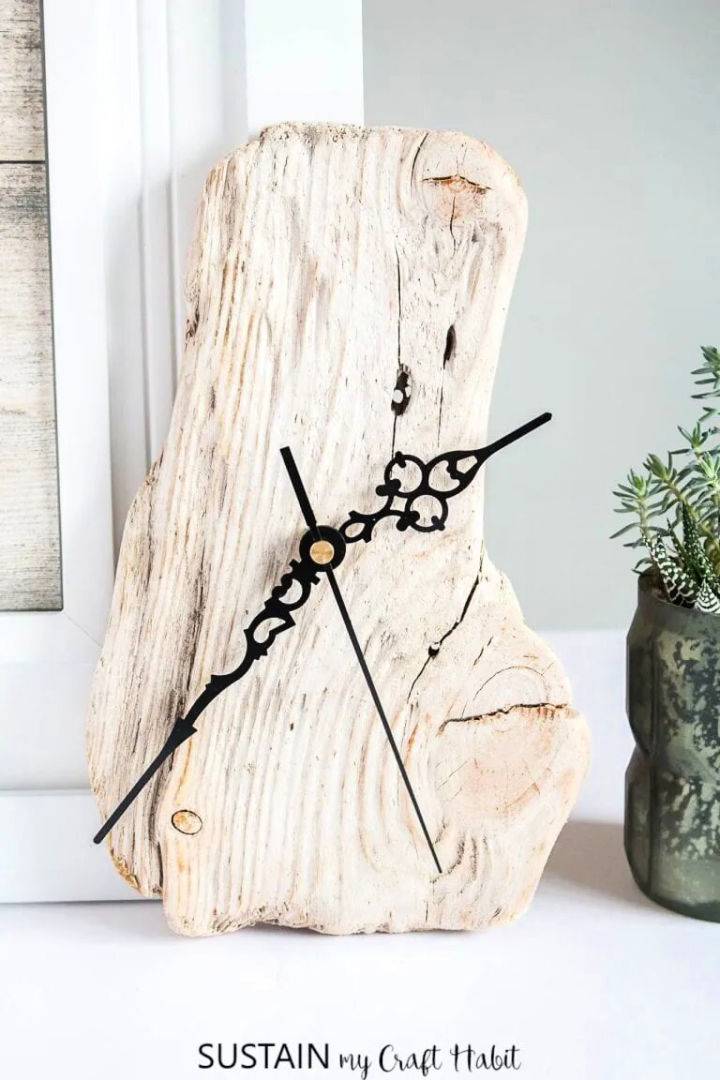
Making a rustic clock from driftwood is a charming way to add a touch of nature to your home decor. At Sustain My Craft Habit, Jane and Sonja guide you through the process with their insightful tutorial. They make it simple to transform a piece of weathered driftwood into a functional and stylish timepiece using a basic clock kit.
With clear instructions on preparing the wood, chiseling out space for the mechanism, and assembling the clock, this project is perfect for anyone who loves DIY crafts. Not only will you end up with a unique clock, but you'll also gain the satisfaction of handcrafting an item that's both practical and aesthetically pleasing.
15. Building a Stained Plywood Wall Clock
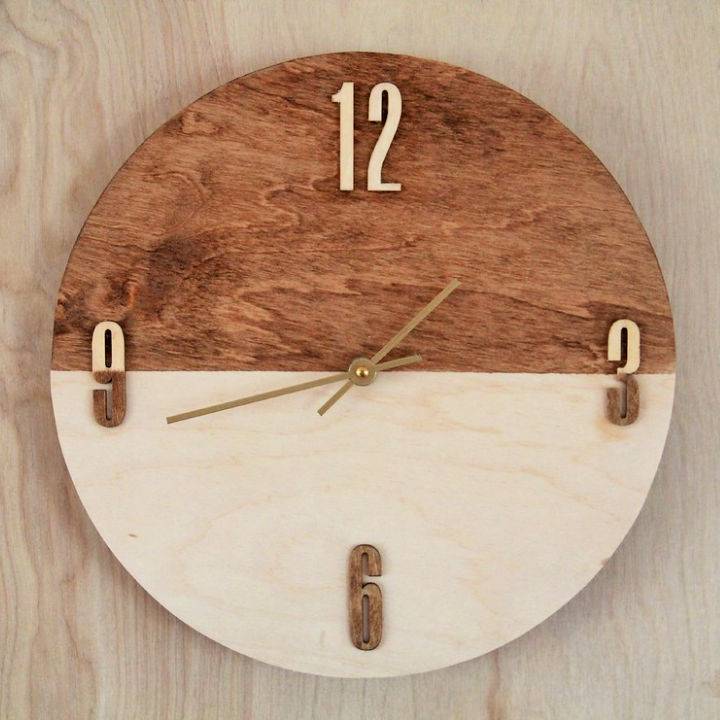
Make a unique, handcrafted timepiece with this easy-to-follow DIY Stained Plywood Wall Clock tutorial. Start by selecting a round plywood panel and sanding the edges for a smooth finish. Use painter's tape to divide the clock face, then apply your chosen stain to one side for a two-tone effect. After staining, drill a central hole for the clock mechanism.
Next, stain the wooden numbers to match, and attach them to the clock face with Mod Podge. Once dry, seal the surface and numbers with wax, cleaning off any excess. Finally, install the clock kit according to its instructions. With these steps, you'll soon have a stylish and personalized wall clock ready to enhance any room's decor. Kristinaclemens
16. Quick and Easy DIY Paper Plate Clock
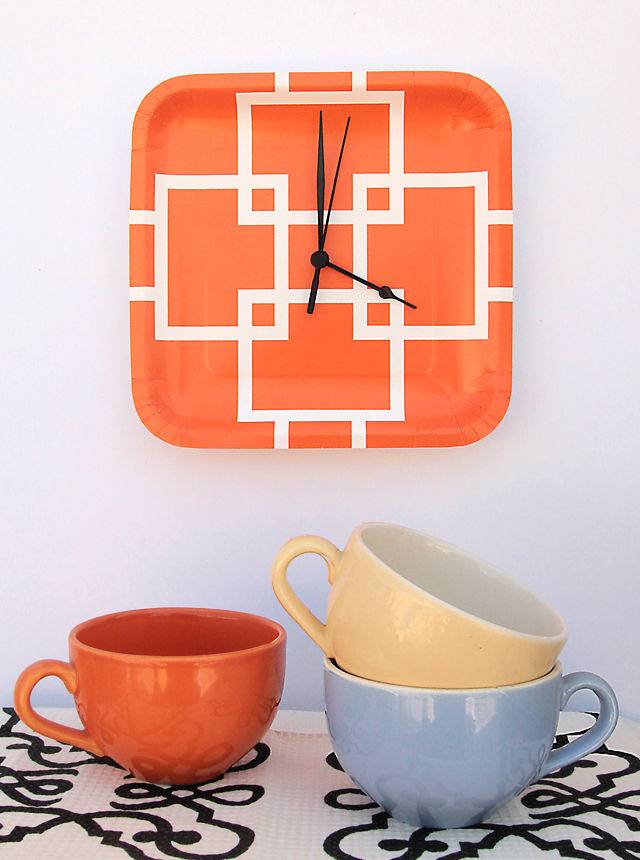
Make a charming paper plate clock in minutes with this simple DIY project from Creative Jewish Mom. Perfect for adding a personalized touch to your home decor, this craft requires only a dinner-sized paper plate and a clock movement kit. Start by finding the plate's center and make a hole.
Insert the clock mechanism, attach the hands, and secure the mechanism with hot glue or double-sided tape. Ideal for gifts or as a unique wall decoration, this cost-effective and enjoyable activity lets you play with different designs for a fresh look. Get ready to craft a timepiece that's as fun to make as it is to display!
17. Giant Reclaimed Wood Clock From an Electrical Reel
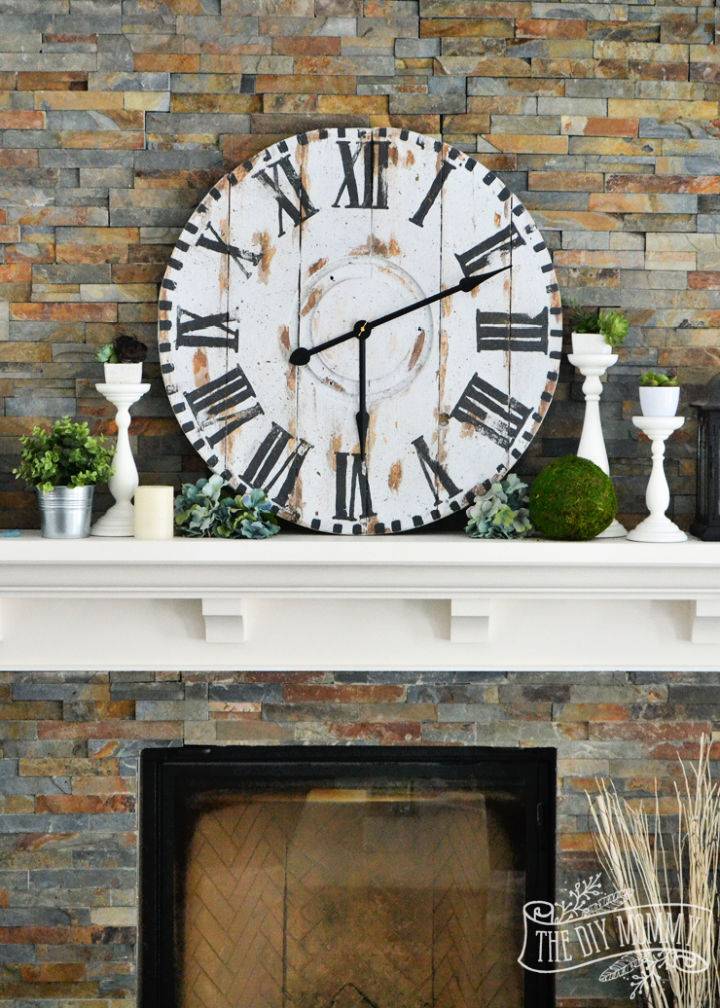
Find creative wood clock designs to bring a rustic charm to your living space. Transform an old electrical reel into a stunning, oversized wooden clock with this step-by-step guide from The DIY Mommy. Christina Dennis shares her creative process, using reclaimed materials and Fusion Mineral Paint, to craft a vintage-inspired timepiece perfect for your mantel. With helpful tips on distressing techniques and painting, even DIY enthusiasts with a modest skill set can make this eye-catching decor.
Gather your materials, like a wooden electrical reel, paint, and a clock kit, and follow the instructions to add a touch of rustic charm to your home. The DIY Mommy not only makes it easy to follow along but also provides inspiration for other wood-themed projects, ensuring your crafting journey is both enjoyable and rewarding.
18. Redo the Thrifted Clock With Step by Step Guide
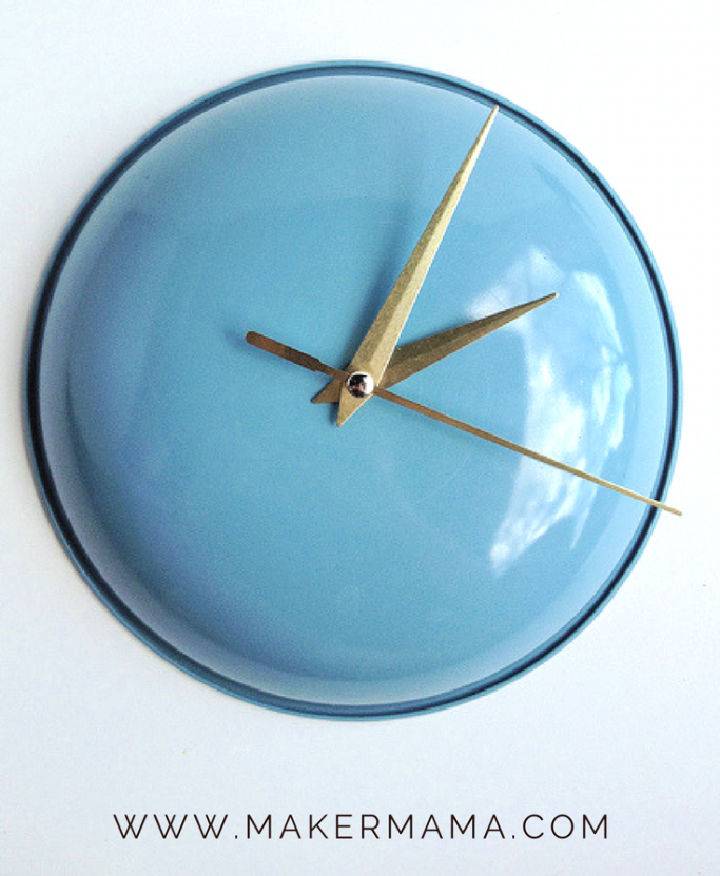
Elevate your home with these stylish clock design ideas, from minimalist to elaborate themes. Remake a thrift store find into a unique timepiece with this inspiring guide from Maker Mama. If you've spotted a charming, orphaned pot lid on your secondhand shopping adventures, consider giving it a new lease on life by converting it into a stylish clock. This project is not only eco-friendly but also requires minimal materials and time.
Grab a suitable pot lid, a clock whose hands match your design, a screwdriver, and some duct tape for extra security. Follow the provided photo tutorial to carefully detach and reattach the clock mechanism. Once complete, you can repurpose the old clock frame into a creative photo display. Get ready to hang your new creation and enjoy the gentle ticking that adds a warm touch to any room.
19. Unique DIY Embroidered Basket Clock
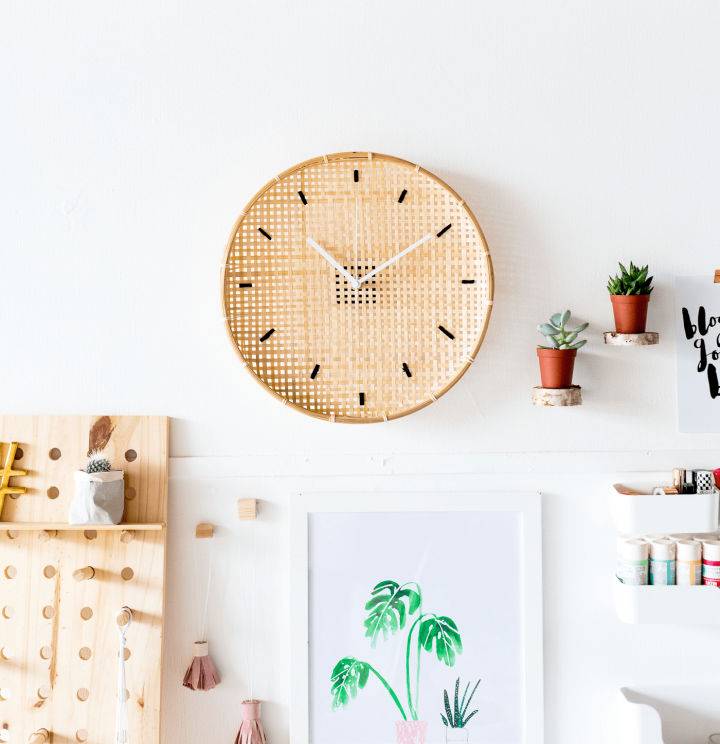
Craft your timepiece with these homemade wooden clock ideas, ideal for woodworking enthusiasts. Transform your living space with a touch of handmade charm by making a unique DIY Embroidered Basket Clock, as featured on Fall For DIY. This craft project is perfect for those who love to blend functionality with personal style. By repurposing a simple basket and adding a dash of embroidery for hour markers, you'll end up with a timepiece that's both practical and visually appealing.
With a straightforward process involving a basketball from IKEA, embroidery floss, a needle, and a clock mechanism, you can craft a clock that adds a natural, cozy vibe to your decor. Ideal for enhancing productivity by reducing phone-checking habits, this clock is a stylish step towards a more focused environment. Follow these steps and soon you'll be admiring your handiwork every time you check the time.
20. How to Make a Holographic Clock

Ready to add a touch of futuristic flair to your home decor? Studio DIY's guide on making a DIY holographic clock is just what you need. With easy-to-follow instructions, you'll transform a simple wood clock base and holographic vinyl into a stunning timepiece. Start by smoothing your clock base with sandpaper and applying a fresh coat of paint.
Once dry, a few layers of high-gloss decoupage glue will prep the surface for the vinyl. Carefully apply the vinyl, smoothing out bubbles for a sleek finish. Complete the look by attaching painted clock hands. This project is perfect for those who love crafting and want to make a statement piece for their space.
21. Pretty Handmade Wood Clock
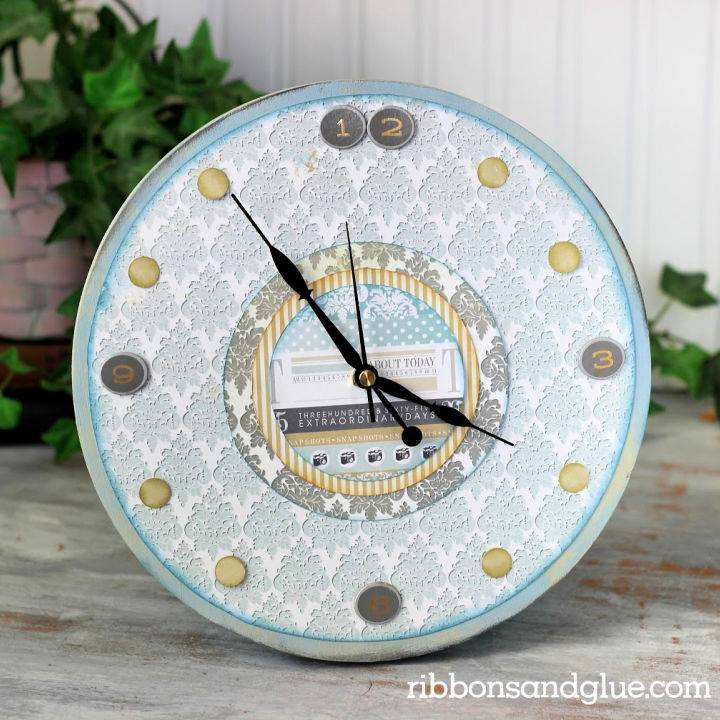
Push the boundaries of timekeeping with these creative clock ideas, designed to inspire and impress. Make your own shabby chic DIY Wood Clock with guidance from Holly Gagnon on Ribbons & Glue. The project is inspired by the timeless shape of circles, incorporating the Ruby Rock-It East Coast Collection's patterns and motifs. Perfect for adding a personalized touch to your home, this craft involves painting a Walnut Hollow base and using a Silhouette to cut out decorative elements.
A helpful hint: look for the AM/PM lettering and clock times on the patterned paper to center your design. This hands-on activity is not only engaging but also provides an opportunity to win the entire Ruby Rock-It collection if shared with Paper Issues. Grab your Art Minds Clock Kit and start crafting your unique timepiece today.
22. Beginner-Friendly DIY Wall Clock
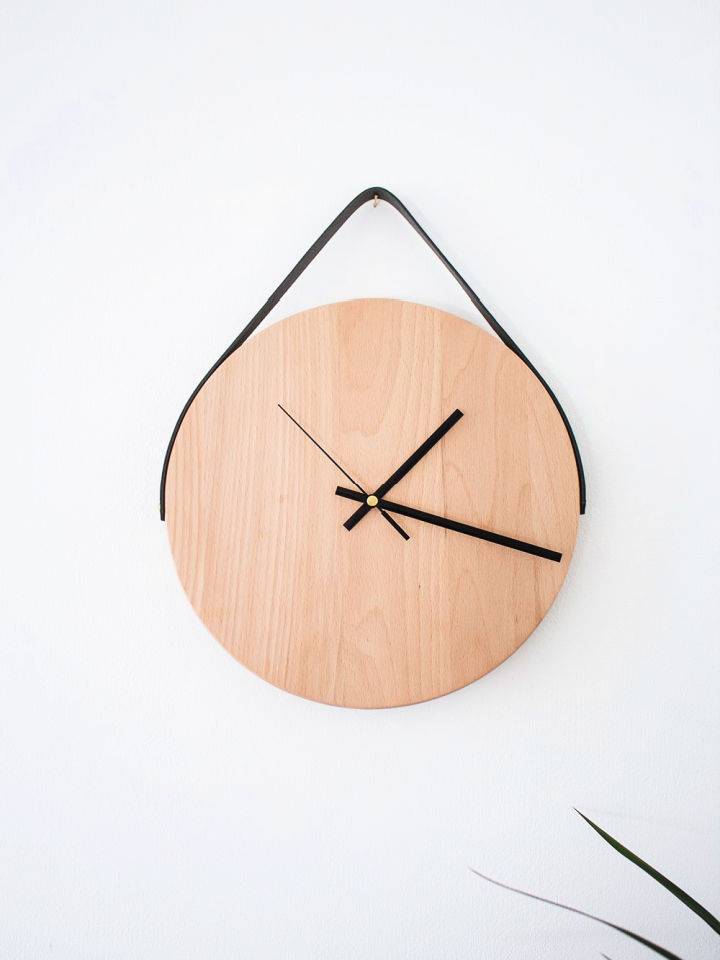
Embrace the warmth of timber with these DIY wood clock ideas, perfect for a weekend project. Convert your home with an easy and stylish DIY project from The Lovely Drawer! Learn how to make a minimalist wall clock using just a wooden chopping board and a few simple tools.
Our step-by-step guide makes it effortless to add a touch of chic to any room without breaking the bank. Get crafting and give your space a personalized update with this affordable home tip. Keep your creativity flowing and watch out for more thrifty and trendy home decor ideas.
23. How to Build a Chalkboard Clock
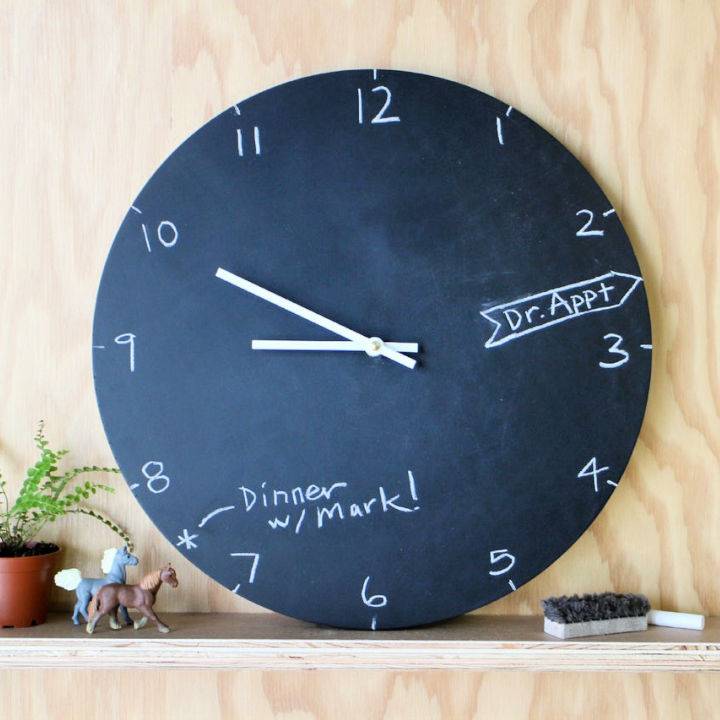
Transform your timekeeping with a touch of creativity by crafting a chalkboard clock, as detailed in the engaging guide on Instructables. This DIY project merges the charm of analog with the practicality of a write-on surface, perfect for jotting down reminders or appointments.
With a comprehensive step-by-step approach, you'll gather supplies, cut wood pieces, and assemble a unique clock. Sanding, painting, and priming steps ensure a smooth, erasable chalkboard finish. Ideal for customizing your schedule, this clock not only keeps you punctual but also adds a personalized touch to your space. Get ready to make a functional piece that's as fun to use as it is to make!
24. Building a Farmhouse-Style Clock
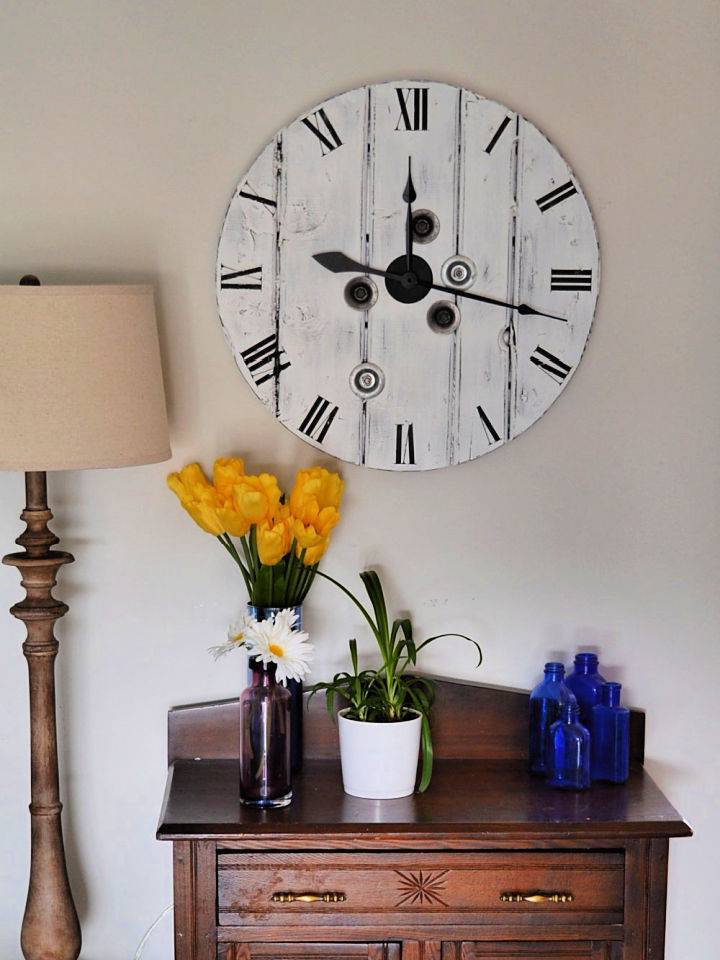
Remake your living space with a touch of rustic charm by crafting a DIY farmhouse clock. The Vanderveen House guides you through making this stylish timepiece using a wooden electrical cable reel. Start by disassembling and sanding the reel, followed by staining it with a dark hue for an authentic farmhouse feel.
With custom vinyl numbers and a layer of milk paint, your clock will boast a classic yet personalized look. This project is perfect for adding character to your home or as a unique gift. Engage in this rewarding DIY endeavor and enjoy the satisfaction of making a beautiful farmhouse clock from scratch.
25. Free Wood Slice Clock Plan
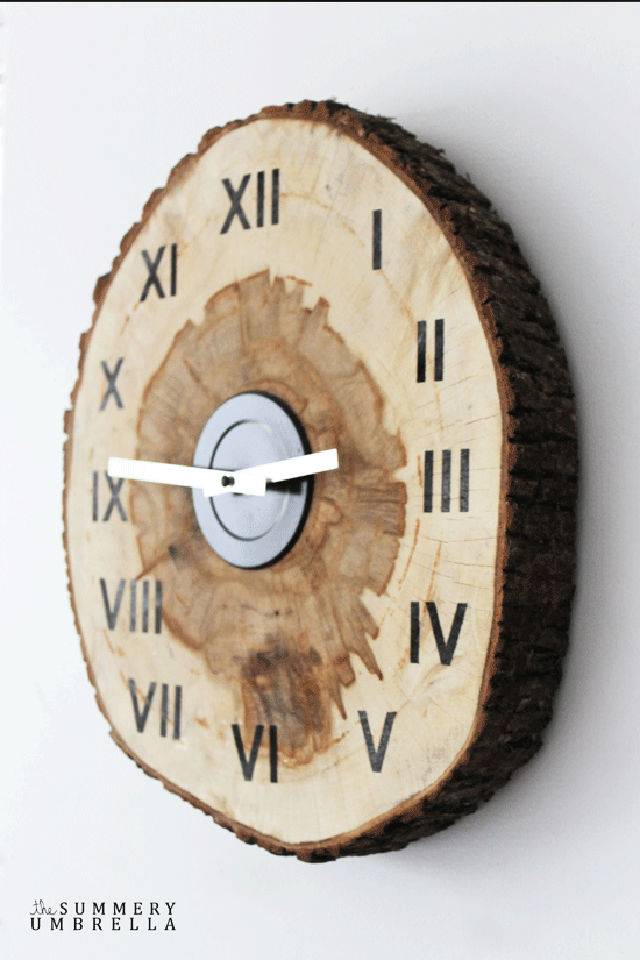
Transform your living space with a touch of rustic charm by making your own wood slice clock. Linda Zahora-Cathcart guides you through a simple DIY process that turns a slice of wood into a functional and stylish timepiece. With clear instructions, you'll learn how to disassemble a working clock, prepare your wood slice, and assemble the clock mechanism with ease.
Add a personalized touch with Roman numerals and finish with clock hands to complete your unique home accessory. This engaging project is perfect for adding a natural element to your decor. Visit the page for a step-by-step tutorial and start crafting a stunning addition to your home today. The Summery Umbrella
Conclusion:
In conclusion, making a homemade DIY clock not only adds a personal touch to your decor but also offers an opportunity to express your creativity and craftsmanship. This guide provided you with all the essentials on how to make a clock, from the materials and tools needed to detailed steps for crafting a wooden clock.
Plus, with answers to frequently asked questions, you're well-equipped to tackle your clock-making project with confidence. Remember, the possibilities are endless when it comes to design, so let your imagination lead the way. Happy crafting as you bring your 25 unique DIY clock ideas to life!



